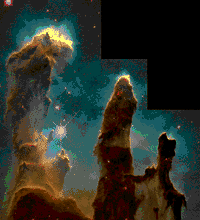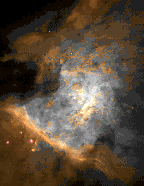
The formation of stars is still a mystery in many ways because we don't know why a single large cloud fragments and form individual stars or why multiple-star systems or planets form. However, we do have a general outline of how stellar formation proceeds. We know that stars are made of gas, and we want to know where we can find plenty of the raw material required. So the prime places to look are giant molecular clouds since they have low temperatures and high densities. | ||

|
It takes a long time for a star to be born. While a condensation of matter in a molecular cloud is contracting to become a true star it is called a protostar. Before becoming a "real" star the so called protostar spends some thousand or even million years contracting and heating. | |
A star first becomes visible only after the stellar wind, mainly consisting of protons streaming away from the star, clears away the surrounding dust and gas and leaves a rotating disk. |

| |
The convection currents cease at the center of the protostar and energy must be transported by radiation in those regions. Slowly, the protostar starts moving toward the Main Sequence. | ||
The story of stellar evolution is the story of the competition between
two forces; gravity and pressure. When those two forces are in balance
the star is stable.
| ||
|
Last modified 4th August 1999 Sarah Amandusson www_astro@mssl.ucl.ac.uk | ||